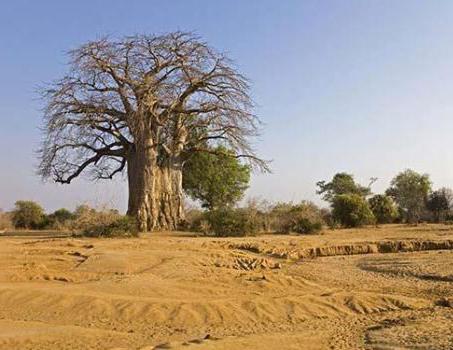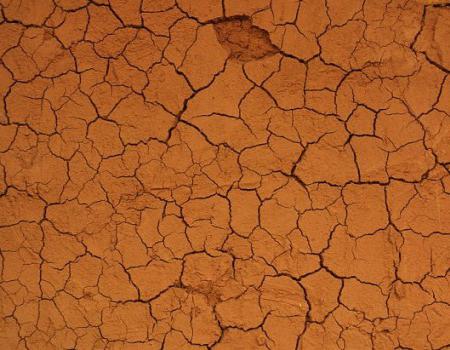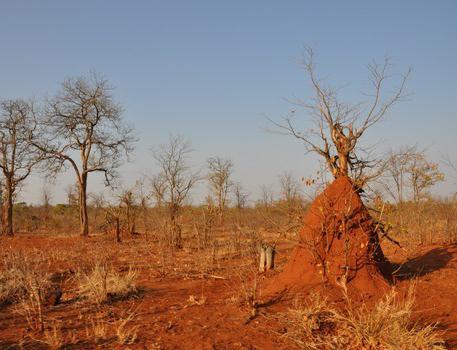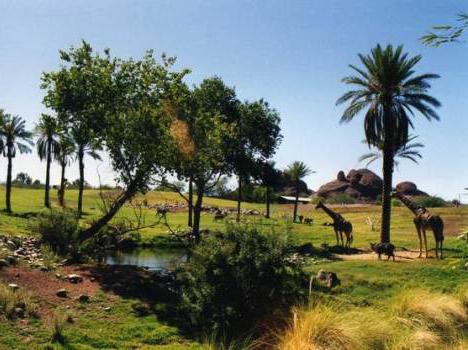Savannah is a natural area dominated by herbaceous vegetation on red lateritic soils. This zonal (PC) is distributed between humid forests and semi-deserts. More than 40% of Africa's area is occupied by the vast expanses of the savannah. Reddish soils are formed under tall-grass vegetation with a predominance of grasses, rare specimens of trees and thickets of shrubs.
Tropical forest steppe
Savannahs, except Africa, are common in Australia and the Indian subcontinent. This type of PC includes campos and llanos in mainland South America. Savannah is often compared to the forest-steppe of the temperate zone of Eurasia. There are some similarities, but more differences. The main features that characterize the savannah:
- soils with a low humus content;
- herbaceous xeromorphic vegetation;
- trees and shrubs with an umbrella-shaped crown;
- rich and varied fauna (unlike the steppes, it has survived).
Campos, a savannah in the Brazilian Highlands, is formed by different types of plant communities. Serrados is distinguished by the presence of undersized trees and shrubs. Limpos forms a tall grass steppe. Llanos on either side of South America are covered with dense grass and separate groups of trees (palms).
African savannahs. Soils and climate
The tropical forest-steppe zone occupies about 40% of the territory on the hot continent.
In the Northern Hemisphere, savannas reach semi-deserts at a latitude of 16-18 °, close to Lake Chad and the sands of the Sahara. The boundary of the distribution of this zonal PC in the south is the Savannah occupy flat areas and rise to significant heights within the East African Plateau.
The predominant types of climate are subequatorial and tropical. Two seasons are clearly distinguishable during the year - wet and dry. The rainy period shortens when moving from the equator to the tropics from 7-9 to 3-4 months. In January, when the wet season begins in the Northern Hemisphere, the dry season begins in the Southern. The total amount of moisture reaches 800-1200 mm / year. Moisture coefficient - less than 1 (insufficient precipitation). Some areas suffer from a meager intake of moisture (K uvl below 0.5-0.3).
What kind of soil in the savannah is formed in such climatic conditions? During the rainy season, nutrients are intensively washed out by water into the lower horizons. When the dry period sets in, the opposite phenomenon is observed - soil solutions rise.

Vegetation type and climate
Having received moisture, the tropical forest-steppe in Africa comes to life. The yellow-brown shades of dry stems are replaced by emerald greens. Leaves grow on those trees and shrubs that have dropped their foliage during a drought; grasses are rapidly stretching out, sometimes reaching 3 m in height. The soil, flora and fauna of African savannahs is formed under the influence of climate. Temperature conditions and humidity depend on the geographic location of the site.
Closer to the border of the equatorial forests, the rainy season lasts about 9 months. A tall grass savanna is formed here; groups of trees and shrubs are more numerous. There are mimosas and palms that form gallery forests along the river valleys. The most interesting representative of the flora of the savannah is the baobab. The trunk of a tree often reaches 45 m in girth.
As you move away from the equator and approach the tropics, the rainy period decreases, typical savannahs develop. The territory bordering on semi-deserts receives moisture for 3 months a year. The vegetation that forms in arid conditions is of the desert type of savannah. At 50 ° C, it differs little from the desert. The North African peoples call these natural sites "Sahel", the South Africans call them "bush".

What soils prevail in the savannah
The soil of the tropical forest-steppe - which gives it iron compounds. This type is characterized by a low humus content - from 1.5 to 3%. The middle part of the profile contains clays; in the lower part, an illuvial-carbonate soil horizon is visible. The above features are typical for East Africa, the northern part of the Australian continent and certain regions of South America.
What kind of soil forms in the savanna depends on the type of moisture. With a sufficiently long dry period, humus accumulates due to the gradual decomposition of vegetation. More in the dry savannas of Africa and the steppes of South America. With regular moistening, a granular structure or shell (hard crust) forms on the surface of the earth.

Soil types
Within the same natural zone, different amounts of precipitation fall, and dry periods differ in duration. Features of the relief and climatic conditions leave an imprint on the type of vegetation on the savannah. Soils are formed by the interaction of all elements of the natural complex. For example, plant residues in the wet forest zone do not have time to decompose, nutrients are washed out by abundant precipitation.
Compared to the red-yellow ferralite soils of forests, more humus accumulates in savannas. Due to the dry period, there is a slow decomposition of plant residues and the formation of humus. The intermediate type is red ferralite substrates of variable moisture forests. Under the grass savannas, there are mainly lateritic and red-brown soils. Chernozems are formed under the dry type of this natural zone. As we approach the desert areas, they are replaced by reddish-brown soils. The soil acquires a bright brownish or brick-red color due to the accumulation of iron ions.

Savannah fauna
The fauna of the tropical forest-steppe is surprisingly rich and diverse. Representatives of all groups of the animal world meet. Spiders, scorpions, snakes, elephants, hippos, rhinos, wild boars find food in the savannah, shelter from the heat of the day or rain. Earthen cones of termitic structures rise everywhere, bringing the flat savannah to life. The soil is inhabited by spiders and small rodents, rustles are constantly heard in the grass - snakes and other reptiles scurry about. Large predators - lions, tigers - deftly hide in the tall grass in order to attack their prey unexpectedly.
Ostriches behave cautiously: high growth and long neck allow a massive bird to notice danger in time and hide its head. Most of the inhabitants of the savannah flee from predators. Ungulate herbivores cover considerable distances: zebras, gazelles, antelopes, buffaloes. Giraffes gracefully eat the delicate foliage of the tallest trees, and clumsy hippos toss and turn in thickets of grass on the banks of the lakes.

Agriculture in the savannah and woodlands
Significant areas of the tropical forest-steppe of Australia and South America are occupied by pastures and the cultivation of cotton, corn, and peanuts. Savannahs and woodlands are also used in Africa. Red-brown soils are fertile when moistened and properly processed. The low culture of agriculture and the lack of land reclamation led to the development of erosion processes. The Sahel zone in Africa is the territory of modern desertification caused by a combination of natural and anthropogenic factors.

Savannah soil conservation issues
The nature of Africa is changing under the influence of man: forests are being cut down, the savannah is plowing up. Vegetation and animals are negatively influenced by anthropogenic factors. The number of predators and ungulates is declining, and the population of primates is under threat. Disruption of the vegetation cover by plowing the savannah or deforestation leads to the rapid destruction of the soil. Showers erode the top fertile layer, exposing a dense mass of clay and iron compounds. It is cemented under the influence of high air temperatures. Such phenomena occur in areas of intensive farming and grazing. The red-brown soils of savannahs need protection and restoration over vast areas in the developing states of Africa and Latin America.




